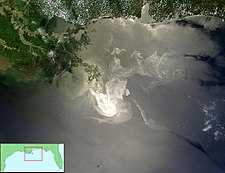Deepwater Horizon oil spill
| Deepwater Horizon oil spill | |
|---|---|

|
|
| Location | Gulf of Mexico near Mississippi River Delta, United States |
| Coordinates | 28°44′17.30″N 88°21′57.40″W / 28.7381389°N 88.3659444°WCoordinates: 28°44′17.30″N 88°21′57.40″W / 28.7381389°N 88.3659444°W |
| Cause | Wellhead blowout |
| Casualties | 11 dead |
| Operator | Transocean under contract for BP |
| Volume | 4.9 million barrels (210,000,000 U.S. gallons; 780,000 cubic meters) ±10% |
| Area | 2,500 to 68,000 sq mi (6,500 to 176,100 km2) |
|
|
The Deepwater Horizon oil spill (also referred to as the BP oil spill, the BP oil disaster, the Gulf of Mexico oil spill, and the Macondo blowout) began on April 20, 2010, in the Gulf of Mexico on the BP-operated Macondo Prospect. Eleven people went missing and were never found and it is considered the largest accidental marine oil spill in the history of the petroleum industry, an estimated 8% to 31% larger in volume than the previously largest, the . The US Government estimated the total discharge at 4.9 million barrels (210 million US gal; 780,000 m3). After several failed efforts to contain the flow, the well was declared sealed on September 19, 2010. Reports in early 2012 indicated the well site was still leaking.
A massive response ensued to protect beaches, wetlands and estuaries from the spreading oil utilizing skimmer ships, floating booms, controlled burns and 1.84 million US gallons (7,000 m3) of Corexit oil dispersant. Due to the months-long spill, along with adverse effects from the response and cleanup activities, extensive damage to marine and wildlife habitats and fishing and tourism industries was reported. In Louisiana, 4.9 million pounds (2.09 million kg) of oily material was removed from the beaches in 2013, over double the amount collected in 2012. Oil cleanup crews worked four days a week on 55 miles of Louisiana shoreline throughout 2013. Oil continued to be found as far from the Macondo site as the waters off the Florida Panhandle and Tampa Bay, where scientists said the oil and dispersant mixture is embedded in the sand. In 2013 it was reported that dolphins and other marine life continued to die in record numbers with infant dolphins dying at six times the normal rate. One study released in 2014 reported that tuna and amberjack that were exposed to oil from the spill developed deformities of the heart and other organs that would be expected to be fatal or at least life-shortening and another study found that cardiotoxicity might have been widespread in animal life exposed to the spill.
Numerous investigations explored the causes of the explosion and record-setting spill. Notably, the U.S. government's September 2011 report pointed to defective cement on the well, faulting mostly BP, but also rig operator Transocean and contractor Halliburton. Earlier in 2011, a White House commission likewise blamed BP and its partners for a series of cost-cutting decisions and an inadequate safety system, but also concluded that the spill resulted from "systemic" root causes and "absent significant reform in both industry practices and government policies, might well recur".
...
Wikipedia
